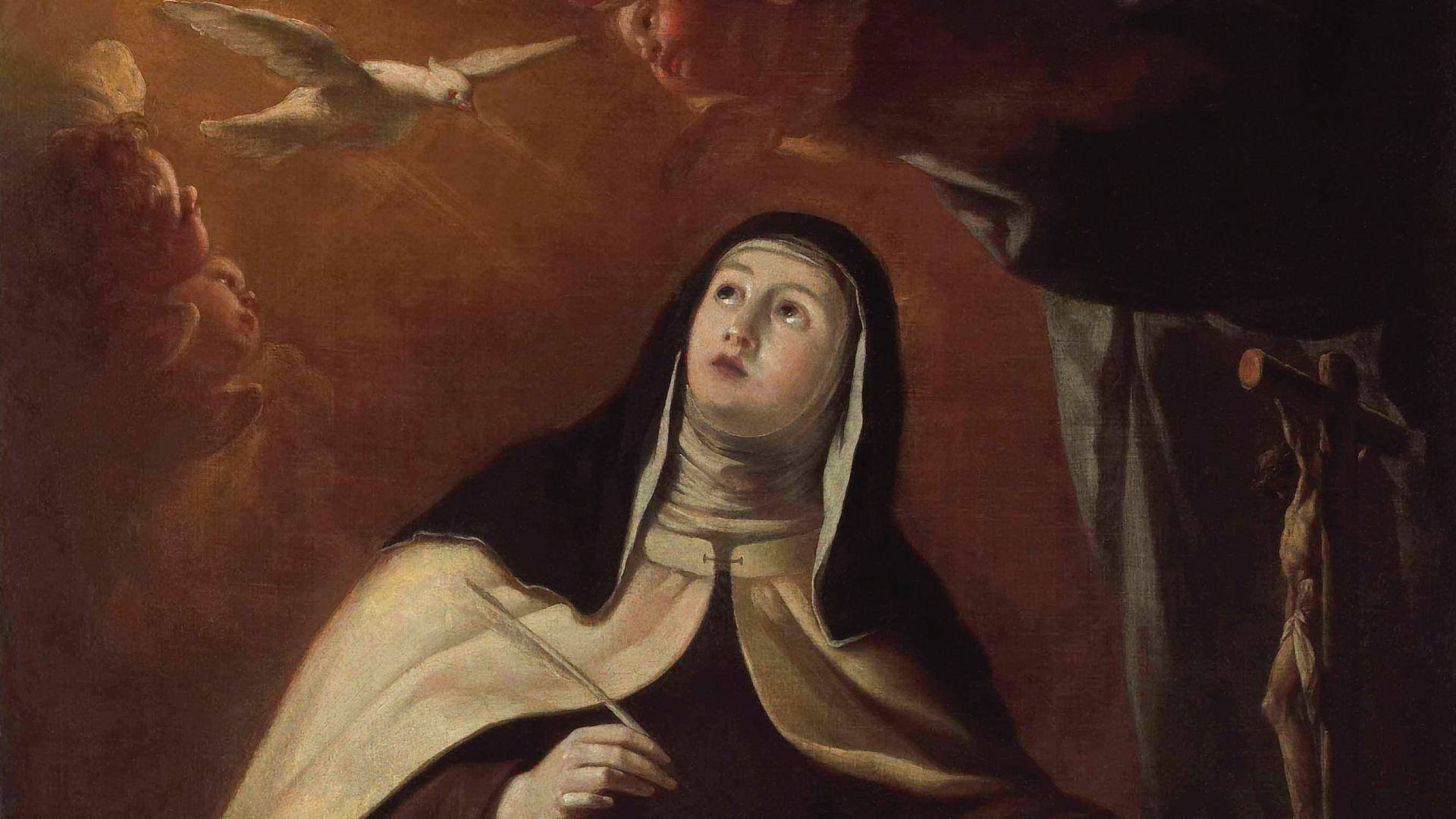

Deacon-structing St. Teresa’s stages of prayer, part 2
Deacon Pedro
Monday, March 1, 2021

Detail of Saint Teresa of Jesus Writing by Antonio Palomino (Source: Wikimedia Commons)
Last week, we learned a bit about one of the Doctors of the Church, St. Teresa of Avila, and what she has to say about prayer. I explained how I related to her four stages of prayer in my own prayer life. I hope that it made sense to you, too.
I first heard about St. Teresa’s stages of prayer during a class with Discalced Carmelite Fr. Dominic Borg, OCD. Fr. Dominic described St. Teresa of Avila as an excellent mentor in the experience of God – not just to pray but to "become a prayer". I don’t think I understood that until I read St. Teresa herself.
In a way, the deepening of the union is exactly that: to become a prayer – and that’s the call to holiness!
Fr. Dominic reminded us that after the prophet Elijah was sent fleeing by Queen Jezebel, he fell asleep (1 King 19:5). Whenever we encounter sleep in the Bible, it signifies change (think of Jacob in Genesis 28 and St. Joseph in Matthew 1 and 2). After Elijah’s sleep, he found God in the silence (1 Kings 19: 9-18). Fr. Dominic suggested that this “silence” is the silence that we should work towards while praying: a silencing of the mind, memory, and understanding. Elijah’s rebellion had built a “mountain” between himself and God, but God blew in the wind and blew that mountain down. God came in the earthquake and destroyed Elijah’s ideologies (which were getting in the way), and God was also in the fire that came and melted everything, including Elijah’s heart of stone. Then, only then, was Elijah able to find God in the silence. And so, we must also silence all those things that get in the way: our expectations, our rebellion, our will, our pride. Once we are able to set all things aside, to truly die to ourselves, God can meet us and water the garden without us getting in the way.
Easier said than done.
It’s also interesting that in that story from 1 Kings, Elijah says that God wasn’t in the wind, the earthquake, or the fire. Was God not there, or was it that Elijah just couldn’t see Him? Fr. Dominic proposed that God was there. Perhaps this is the experience we sometimes have in the first of St. Teresa’s stages of prayer: We feel that we have to work at it, but really we just need to let go. God is there.
According to St. Teresa, there are three elements necessary for prayer: humility, love of neighbour, and detachment. We can’t just rest in God’s arms all the time. We must work at charity and loving our neighbour. Humility is also necessary so we can get ourselves out of the way in order to find detachment.
Being detached means being separate, which is the meaning of the word “holy”.
Fr. Dominic explained to us that the Carmelite mission is to bring heaven to earth – it’s an inward journey. This is what I understand the four stages of prayer to be: an inward journey. And if in the fourth stage one is in complete union with God, that is heaven on earth! I’ll never forget this beautiful quote that Fr. Dominic shared: “The saints are not in Heaven; Heaven is in the saints.”
As I already mentioned last week, I don’t think I’ve ever passed far beyond the first stage of prayer, or at least this is where I spend most of my prayer time. If I am generous with myself, I can see that perhaps I have had glimpses of the second stage, where I lose some consciousness of having to “do” and it seems as though the prayer is coming out of me without much effort. This happens to me most during Morning and Evening Prayer with the intentions. I am most distracted during the Psalms and Canticles, but something happens when I open myself up to those petitions that are deepest in my heart: I find that I am praying without thinking and without effort, but this happens so briefly, it is hardly the second stage. (Perhaps it means that I am called to be a pray-er of other people’s intentions?) I have been in situations of, perhaps, a deeper stage of union or a longer period in the second stage, where I feel complete rest or complete surrender (complete for a beginner). As I mentioned last week, this has only happened during Charismatic conferences or retreats, sometimes at Mass, and in times of deep sorrow or need.
If you struggle with prayer, you are not alone. You may find it a struggle to engage in spiritual reading. My struggle with St. Teresa was that, while I enjoyed her casual writing style, I also found it a bit scattered and distracted, and so it was hard to follow the through-line of her explanations. I am also not sure that these stages describe my prayer journey perfectly. I understand the quest for a deeper union with God – that’s what I try to live for – but I don’t think I am called to be a mystic and wonder if these stages would apply to a non-mystic. But that doesn’t mean that I didn’t benefit from reading her. I learned that I have to stop working so hard at prayer and simply be. Prayer is not something that we do; rather, it is a relationship.
God is the doer, and I have to let Him do and be. I have to work at surrender.
If you do struggle, stick with it. Remember that spiritual reading is not an exercise; it is prayer itself. If it means that if you are not intellectually retaining what you are reading (or listening to, if you choose an audio book) or you fall asleep, don’t let that bother you. Trust that God will speak to you through the writings of these holy men and women just as much as He speaks to us through Scripture.
Fr. Dominic Borg told us that when we open our hearts, we are ready to receive this gift of contemplation that God wants to give us. He also told us that every Christian needs to be a mystic or s/he is nothing. As I just said, I don’t know if I can be a mystic, but I can open my heart to receive the gift of contemplation. We have to take off our sandals because “this is holy ground” (Exodus 3:5); taking off sandals is death – putting them on again is resurrection.
I am realizing as I write this that deacon-structing St. Teresa has helped us deacon-struct contemplation a little bit. How can we be more contemplative? How can this Lenten Season be a time for more contemplation?
One thing I suggest, which I started doing myself many years ago, is setting a place and time aside for prayer (for those of you tuning in to our new Lenten series for kids, Yes, Lord!, you’ll know that this is the activity for the first week of Lent). I’ve always enjoyed a life where prayer and living is fluid. I mean that prayer doesn’t have to be structured and that any activity or work can be prayer and I don’t have to set aside time: I can pray anywhere and in doing anything. But I’ve learned that setting time aside is extremely beneficial. So find a place and a time for your daily prayer and stick to it.
I’ve also learned that it's not wrong to expect something out of prayer. If we long for a deeper union with God in this life (as we move to a complete union with Him in Heaven), then it’s perfectly OK to hope and strive for that, and to expect it as well.
Come back next week, and I’ll share a bit more about spiritual reading that I learned from my mother. As you pursue your search for good spiritual reading, you may want to check out The Essential Writings of Christian Mysticism, edited by Bernard McGinn.
 Every week, Deacon Pedro takes a particular topic apart, not so much to explore or explain the subject to its fullness, but rather to provide insights that will deepen our understanding of the subject. And don’t worry, at the end of the day he always puts the pieces back together. There are no limits to deaconstructing: Write to him and ask any questions about the faith or Church teaching: [email protected]. Follow him on Facebook, Twitter and Instagram.
Every week, Deacon Pedro takes a particular topic apart, not so much to explore or explain the subject to its fullness, but rather to provide insights that will deepen our understanding of the subject. And don’t worry, at the end of the day he always puts the pieces back together. There are no limits to deaconstructing: Write to him and ask any questions about the faith or Church teaching: [email protected]. Follow him on Facebook, Twitter and Instagram.
 Every week, Deacon Pedro takes a particular topic apart, not so much to explore or explain the subject to its fullness, but rather to provide insights that will deepen our understanding of the subject. And don’t worry, at the end of the day he always puts the pieces back together. There are no limits to deaconstructing: Write to him and ask any questions about the faith or Church teaching: [email protected]. Follow him on Facebook, Twitter and Instagram.
Every week, Deacon Pedro takes a particular topic apart, not so much to explore or explain the subject to its fullness, but rather to provide insights that will deepen our understanding of the subject. And don’t worry, at the end of the day he always puts the pieces back together. There are no limits to deaconstructing: Write to him and ask any questions about the faith or Church teaching: [email protected]. Follow him on Facebook, Twitter and Instagram.Related Articles:
<<













